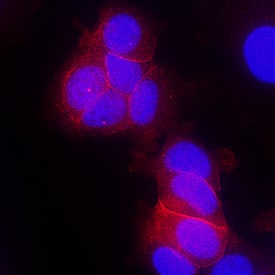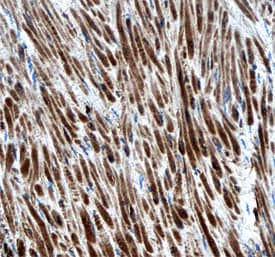Human ErbB4/Her4 Antibody Summary
Gln26-Arg649
Accession # Q15303
Applications
Please Note: Optimal dilutions should be determined by each laboratory for each application. General Protocols are available in the Technical Information section on our website.
Scientific Data
 View Larger
View Larger
ErbB4/Her4 in MCF‑7 Human Cell Line. ErbB4/Her4 was detected in immersion fixed MCF‑7 human breast cancer cell line using Mouse Anti-Human ErbB4/Her4 Monoclonal Antibody (Catalog # MAB1131) at 10 µg/mL for 3 hours at room temperature. Cells were stained using the NorthernLights™ 557-conjugated Anti-Mouse IgG Secondary Antibody (red; Catalog # NL007) and counterstained with DAPI (blue). Specific staining was localized to plasma membrane. View our protocol for Fluorescent ICC Staining of Cells on Coverslips.
 View Larger
View Larger
ErbB4/Her4 in Human Colon Cancer Tissue. ErbB4/Her4 was detected in immersion fixed paraffin-embedded sections of human colon cancer tissue using Mouse Anti-Human ErbB4/Her4 Monoclonal Antibody (Catalog # MAB1131) at 15 µg/mL overnight at 4 °C. Tissue was stained using the Anti-Mouse HRP-DAB Cell & Tissue Staining Kit (brown; Catalog # CTS002) and counterstained with hematoxylin (blue). Specific staining was localized to smooth muscle cells. View our protocol for Chromogenic IHC Staining of Paraffin-embedded Tissue Sections.
Preparation and Storage
- 12 months from date of receipt, -20 to -70 °C as supplied.
- 1 month, 2 to 8 °C under sterile conditions after reconstitution.
- 6 months, -20 to -70 °C under sterile conditions after reconstitution.
Background: ErbB4/Her4
ErbB4, also called Her4 (human epidermal growth factor receptor 4), is a type I membrane glycoprotein that is a member of the ErbB family of tyrosine kinase receptors. ErbB family members serve as receptors for the epidermal growth factor (EGF) family of growth factors. ErbB4 is expressed in normal skeletal muscle, heart, pituitary, brain and several breast carcinomas. ErbB4 ligands include the neuregulins, beta-cellulin and heparin-binding EGF-like growth factor (HB-EGF). Monomeric ErbB4 binds its ligands with low affinity. Typically, heterodimerization with ErbB2 forms the high affinity receptor complex. However, ErbB4 has also been shown to heterodimerize with both ErbB1 and ErbB3. It has been suggested that the identity of the ligand may influence the dimerization partner. Because ErbB3 contains a defective kinase domain, the kinase domain of ErbB2 is responsible for initiating the tyrosine phosphorylation signal through the heterodimeric receptor. It has been found that a discrete three amino acid signal in the ErbB3 cytoplasmic domain is critical for transactivation of ErbB2. Interestingly, this same three amino acid signal has been found in ErbB4 and ErbB1 (EGFR). Several ErbB4 isoforms exist. Two of these differ in the presence of juxtamembrane extracellular sequences which regulate the ability of TACE (TNF-alpha converting enzyme) to proteolytically cleave ErbB4 from the cell surface. These isoforms exhibit tissue-specific expression. Another isoform lacks the phosphoinositide 3-kinase activation sequence present in the ErbB4 cytoplasmic domain. Human ErbB4 consists of 1308 amino acids (aa) with a 25 aa signal sequence, a 626 aa extracellular domain, a 24 aa transmembrane region, and a 633 aa cytoplasmic domain. ErbB4 appears to play important roles in neuronal development, development of the heart and cancer.
- Plowman, G.D. et al. (1993) Proc. Natl. Acad. Sci. USA 90:1746.
- Elenius, K. et al. (1997) J. Biol. Chem. 272:26761.
- Elenius, K. et al. (1999) Oncogene 18:2607.
- Rio, C. et al. (2000) J. Biol. Chem. 275:10379.
- Emkey, R. and C.R. Kahn (1997) J. Biol. Chem. 272:31172.
- Sundaresan, S. et al. (1998) Endocrinology 139:4756.
- Schaefer, G. et al. (1999) J. Biol. Chem. 274:859.
- Schlessinger, J. (2000) Cell 103:211.
- Daly, R.J. (1999) Growth Factors 16:255.
Product Datasheets
Citations for Human ErbB4/Her4 Antibody
R&D Systems personnel manually curate a database that contains references using R&D Systems products. The data collected includes not only links to publications in PubMed, but also provides information about sample types, species, and experimental conditions.
6
Citations: Showing 1 - 6
Filter your results:
Filter by:
-
Spatial Transcriptional Mapping of the Human Nephrogenic Program
Authors: Lindstrom NO, Sealfon R, Chen X et al.
Dev Cell
-
Progressive Recruitment of Mesenchymal Progenitors Reveals a Time-Dependent Process of Cell Fate Acquisition in Mouse and Human Nephrogenesis
Authors: Lindstrom NO, De Sena Brandine G, Tran T et al.
Dev. Cell
-
Axial nephron fate switching demonstrates a plastic system tunable on demand
Authors: Achieng, MA;Schnell, J;Fausto, CC;Csipán, RL;Koppitch, K;Thornton, ME;Grubbs, BH;Lindström, NO;
Nature communications
Species: Human
Sample Types: Organoid
Applications: Immunohistochemistry -
miR-143, miR-222, and miR-452 are useful as tumor stratification and noninvasive diagnostic biomarkers for bladder cancer.
Authors: Puerta-Gil P, Garcia-Baquero R, Jia AY, Ocana S, Alvarez-Mugica M, Alvarez-Ossorio JL, Cordon-Cardo C, Cava F, Sanchez-Carbayo M
Am. J. Pathol., 2012-03-15;180(5):1808-15.
Species: Human
Sample Types: Whole Tissue
Applications: IHC-P -
The fibroblast-derived paracrine factor neuregulin-1 has a novel role in regulating the constitutive color and melanocyte function in human skin.
Authors: Choi W, Wolber R, Gerwat W
J. Cell. Sci., 2010-08-24;123(0):3102-11.
Species: Human
Sample Types: Cell Lysates
Applications: Western Blot -
Microbead arrays for the analysis of ErbB receptor tyrosine kinase activation and dimerization in breast cancer cells.
Authors: Khan IH, Zhao J, Ghosh P, Ziman M, Sweeney C, Kung HJ, Luciw PA
Assay Drug Dev Technol, 2010-02-01;8(1):27-36.
Species: Human
Sample Types: Cell Lysates
Applications: Immunoprecipitation, Luminex Development
FAQs
No product specific FAQs exist for this product, however you may
View all Antibody FAQsReviews for Human ErbB4/Her4 Antibody
Average Rating: 5 (Based on 2 Reviews)
Have you used Human ErbB4/Her4 Antibody?
Submit a review and receive an Amazon gift card.
$25/€18/£15/$25CAN/¥75 Yuan/¥2500 Yen for a review with an image
$10/€7/£6/$10 CAD/¥70 Yuan/¥1110 Yen for a review without an image
Filter by:





